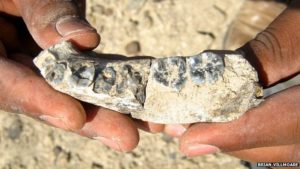
The discovery is 400,000 years older than researchers previously believed humans first existed, according to Brian Villmoare, a professor at the University of Neveda in Las Vegas.
The fossil jawbone suggests climate change spurred the transition from tree dweller to upright walker—and provides further evidence that the first humans were Africans.
The 2.8 million-year-old lower jawbone was found in the Ledi-Geraru research area, Afar Regional State, by “stunned” Ethiopian student Chalachew Seyoum.
“The moment I found it,” he told BBC News, “I realized that it was important, as this is the time period represented by few (human) fossils in Eastern Africa.”
Villamore added that the finding makes a clear link between an iconic 3.2 million-year-old hominin—human-like primate—discovered in the same area in 1974, called “Lucy.”
He added the scientists “are arguing” that Lucy’s kind, which belonged to the species Australopithecus afarensis, evolved into the very first primitive humans.
But it is a sparse time between the period when Lucy and her kin were alive and the emergence of Homo erectus (with its relatively large brain and humanlike body proportions) two million years ago.
The fossil is of the left side of the lower jaw, along with five teeth. The back molar teeth are smaller to those of other hominins living in the area and are one of the features that distinguish humans from more primitive ancestors, according to William Kimbel, director of Arizona State University’s Institute of Human Origins.
Scientists said the discovery forced them to pose the question: “What it is to be human?
“Previously, the oldest fossil attributed to the genus Homo was an upper jaw from Hadar, Ethiopia, dated to 2.35m years ago,” Chris Stringer of the Natural History Museum of London to BBC News. “So this new discovery pushes the human line back by 400,000 years or so, very close to its likely (pre-human) ancestor. Its mix of primitive and advanced features makes the Ledi jaw a good transitional form between (Lucy) and later humans.”
A computer reconstruction of a skull belonging to the species Homo habilis, which has been published in the Nature journal, indicates that it may well have been the evolutionary descendant of the species announced with this new discovery.
The researcher involved, Fred Spoor of University College London, told BBC News that, taken together, the new findings lifted a veil on a key period in the evolution of our species.
“By discovering a new fossil and re-analyzing an old one we have truly contributed to our knowledge of our own evolutionary period, stretching over a million years, that had been shrouded in mystery,” he said.


